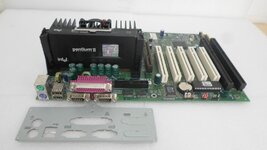Update: Apparently, despite having installed countless ATX I/O Shields over the past 25 years or so, I did it wrong. Apparently, I should have started with the botton edge, then pushed the two sides in, and finally pushed the top side in. If you start with the top edge, you won't have enough leverage to push the bottom edge into the case.
That being said, there could be technical tolerances at play here, and the original InWin shields were shaped differently. Sine someone could want to re-create one for some strange reason, I'm still going to collect the data to facilitate the design of 2D/3D models.
*
The InWin A500 and its sibling cases can use a proprietary I/O shield design. Instead of snapping in like current ATX cases, or being retained by screws like some early ATX cases, the proprietary shield design uses two tabs to hold the shield in place.
And although the opening looks big enough to snap a modern I/O shield in place, it’s not actually the right size to do so. IIRC, it’s too narrow. (Update: this was likely due to user error, though there could be mechanical tolerances at play that make this more difficult on some cases.)
I want to make my vintage builds look like vintage builds, including proper I/O shields in ATX cases. But what are you to do when your second PC was in an InWin A500 case and you can’t find the proper I/O shield or an existing 3D model to print one?
You ask the TD community for help, that’s what!
I have an InWin A500 case that needs an I/O shield. Despite several saved searches to try to catch any I/O shields that get listed, I’ve yet to spot an InWin one by itself. I’ve seen one or two in a case, but the price was prohibitive.
I’m hoping someone might have one already that could either create a 3D model, or maybe get the community the data needed (dimensions and some good photographs) so we can start to create 3D models. Then all these InWin cases that show up on eBay without shields can one again Rick an awesome vintage build!
Who’s in?
That being said, there could be technical tolerances at play here, and the original InWin shields were shaped differently. Sine someone could want to re-create one for some strange reason, I'm still going to collect the data to facilitate the design of 2D/3D models.
*
The InWin A500 and its sibling cases can use a proprietary I/O shield design. Instead of snapping in like current ATX cases, or being retained by screws like some early ATX cases, the proprietary shield design uses two tabs to hold the shield in place.
I want to make my vintage builds look like vintage builds, including proper I/O shields in ATX cases. But what are you to do when your second PC was in an InWin A500 case and you can’t find the proper I/O shield or an existing 3D model to print one?
You ask the TD community for help, that’s what!
I have an InWin A500 case that needs an I/O shield. Despite several saved searches to try to catch any I/O shields that get listed, I’ve yet to spot an InWin one by itself. I’ve seen one or two in a case, but the price was prohibitive.
I’m hoping someone might have one already that could either create a 3D model, or maybe get the community the data needed (dimensions and some good photographs) so we can start to create 3D models. Then all these InWin cases that show up on eBay without shields can one again Rick an awesome vintage build!
Who’s in?
Last edited:

